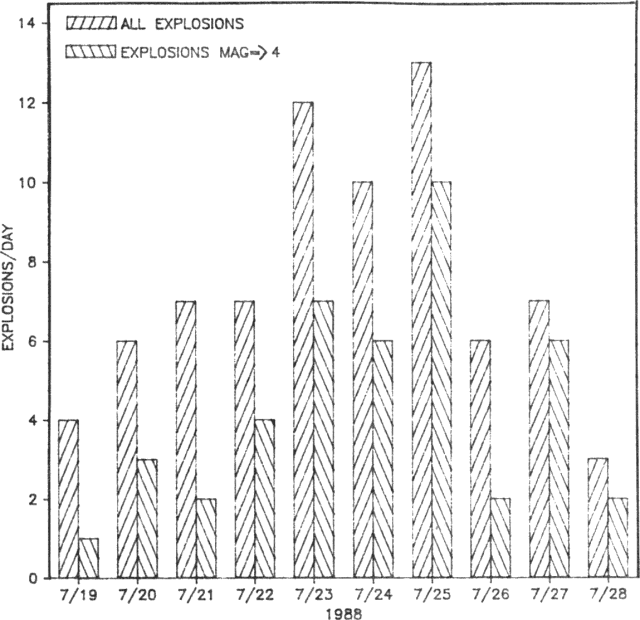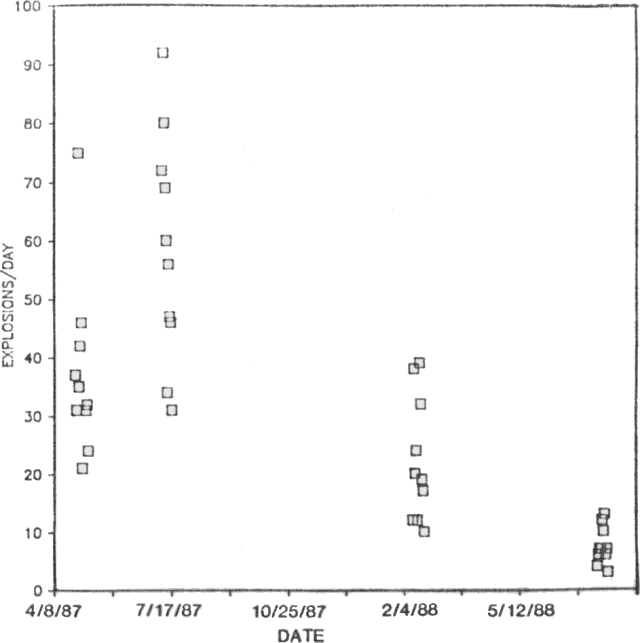Report on Arenal (Costa Rica) — July 1988
Scientific Event Alert Network Bulletin, vol. 13, no. 7 (July 1988)
Managing Editor: Lindsay McClelland.
Arenal (Costa Rica) Explosions and lava flow; one climber killed
Please cite this report as:
Global Volcanism Program, 1988. Report on Arenal (Costa Rica) (McClelland, L., ed.). Scientific Event Alert Network Bulletin, 13:7. Smithsonian Institution. https://doi.org/10.5479/si.GVP.SEAN198807-345033
Arenal
Costa Rica
10.463°N, 84.703°W; summit elev. 1670 m
All times are local (unless otherwise noted)
Activity at Arenal remained similar to that of previous years. Short lava flows were extruded, accompanied by periodic Strombolian explosions that averaged ~10/day on seismic records (figure 15). Earthwatch observers continuously recorded the number of Vulcanian explosions and estimated sound magnitudes 19-28 July. A total of 89 explosions were recorded during the 10-day period (figure 16), a decline from 418 during 28 April-9 May 1987, 395 during 10-19 July 1987, and 130 during 12-21 February 1988 (figure 17). Geologists noted that similar decreases during the 20-year eruption have been followed by renewed increases in the frequency of explosions. Between observations on 18 June and 18 July, a blocky lava flow had moved ~1 km S from the summit crater but had ceased moving by 18 July. On 16 June, geologists observed considerable searing of marginal forests caused by a number of hot avalanches that moved down the headwaters of the Río Tabacón, reaching 1-1.5 km from the summit. On 6 July, a climber died near Arenal's crater rim after being struck in the head by tephra. The victim and a companion had approached to ~3 m from the crater rim when the explosion occurred. The second climber escaped with first- and second-degree burns and a head cut; a third, who had not approached the crater, was uninjured.
 |
Figure 15. Daily number of volcanic earthquakes recorded at Arenal by station FOR, January-July 1988. Courtesy of Guillermo Alvarado I. |
 |
Figure 16. Total number of explosions and number of explosions with subjective magnitudes >4 at Arenal 19-28 July 1988, based on a qualitative sound magnitude scale of 1-10. Courtesy of W. Melson. |
 |
Figure 17. Explosions/day at Arenal during three observation periods, April 1987-July 1988. Courtesy of W. Melson. |
Geological Summary. Conical Volcán Arenal is the youngest stratovolcano in Costa Rica and one of its most active. The 1670-m-high andesitic volcano towers above the eastern shores of Lake Arenal, which has been enlarged by a hydroelectric project. Arenal lies along a volcanic chain that has migrated to the NW from the late-Pleistocene Los Perdidos lava domes through the Pleistocene-to-Holocene Chato volcano, which contains a 500-m-wide, lake-filled summit crater. The earliest known eruptions of Arenal took place about 7000 years ago, and it was active concurrently with Cerro Chato until the activity of Chato ended about 3500 years ago. Growth of Arenal has been characterized by periodic major explosive eruptions at several-hundred-year intervals and periods of lava effusion that armor the cone. An eruptive period that began with a major explosive eruption in 1968 ended in December 2010; continuous explosive activity accompanied by slow lava effusion and the occasional emission of pyroclastic flows characterized the eruption from vents at the summit and on the upper western flank.
Information Contacts: W. Melson, SI; J. Barquero, R. Saenz, and E. Fernández, OVSICORI; G. Alvarado, ICE; The Tico Times.

